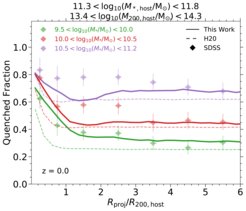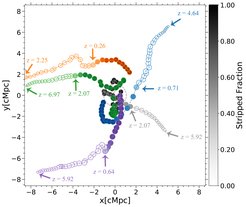Galaxy formation with L-GALAXIES: modelling the environmental dependency of galaxy evolution
The colours and star formation rates of galaxies are strongly correlated with each other out to distances as large as 10 Megaparsecs. However, current galaxy formation models fail to reproduce these large-scale correlations accurately. Scientists from MPA, the University of Surrey, and Heidelberg University are in the process of updating the Munich galaxy formation model, L-GALAXIES, with a sophisticated and accurate method to model environmental effects for all galaxies. The most recent updated model is in significantly better agreement with observations than its predecessors and exhibits a stronger environmental dependency of galaxy properties out to several Megaparsecs from the centers of their dark matter haloes.

Modern theories of galaxy formation and evolution operate within the framework of the Lambda Cold Dark Matter (LCDM) cosmological model. One of the critical assumptions of LCDM is that cold dark matter, as the dominant form of matter in the Universe, interacts only gravitationally with itself and with other matter in the Universe. However, the photons that we observe with our telescopes originate from stars and gas in galaxies. This baryonic matter interacts in much more complicated ways than the weakly interacting cold dark matter. Modelling these baryonic components and their interactions as galaxies form and evolve within dark matter haloes is one of the most challenging topics in astrophysics.
According to the standard hierarchical structure formation theory, baryonic matter accretes into the gravitational potential wells of dark matter structures. It then undergoes cooling and contraction, which eventually leads to the formation of stars and galaxies. Furthermore, the evolution of baryonic matter and galaxies is influenced by a set of complex physical processes including the cooling of gas to form molecular clouds, star formation, galaxy mergers, energetic feedback processes from supernovae, and matter accretion onto black holes. This motivates the development of a comprehensive theory of galaxy formation and evolution.

In addition to intrinsic physical processes, the evolution of galaxies will also depend on the environment in which they are located. As a galaxy orbits within a dark matter halo, a drag force caused by its relative bulk motion with respect to the surrounding gaseous medium (commonly referred to as ram-pressure) will cause the more weakly bound gas in the galaxy to be lost (see Fig. 1). Gravitationally-induced tidal forces can also act to strip gas and stars out of the low-density outer regions of galaxies. Both processes act to deplete the gas reservoirs of galaxies and reduce the star formation in these systems.
The Munich semi-analytic model, L-GALAXIES, implements the key physical processes involved in galaxy formation and evolution on top of halo merger trees extracted from dark-matter-only simulations. As there is no hydrodynamical interaction in the underlying simulations, baryonic environmental processes need to be modelled explicitly using analytical approximations. Traditionally, L-GALAXIES, as well as many other analytic and semi-analytical models, have considered environmental processes only for satellite galaxies within a fixed boundary, typically the virial radius of the host halo. An even simpler approximation is that all galaxy properties can be linked only to the mass of their host dark matter halo. This is the fundamental ansatz of all halo occupation distribution (HOD) models, which are often used as a way of analyzing and interpreting results from large galaxy surveys.

Both assumptions, that environmental processes only depend on halo mass and that they stop at some fixed halo boundary close to the virial radius, are physically incorrect. To demonstrate this in detail, we carried out accurate object-by-object comparisons between L-GALAXIES and the IllustrisTNG hydrodynamical simulations and showed that environmental effects influence galaxies up to much larger halocentric distances (several virial radii) in the hydrodynamical simulation. Furthermore, observational studies have demonstrated that environmental effects extend out to distances well beyond the halo boundary. Therefore, without self-consistent modelling of environmental processes for all galaxies, it is impossible to robustly reproduce the properties of galaxies that reside in different environments. This seriously compromises the accuracy with which key large-scale structure clustering statistics can be predicted.
In our work, we present an updated version of L-GALAXIES with a new gas stripping method. Extending earlier work, we directly measure the local environmental properties of galaxies using the particle data of the simulations. In this way, we are able to treat ram-pressure stripping more accurately for all galaxies. We fully re-calibrate the modified L-GALAXIES model using a Markov Chain Monte Carlo (MCMC) method with the stellar mass function and the quenched fraction of galaxies as a function of stellar mass as constraints. Due to this re-calibration, global galaxy population relations, including the stellar mass function, quenched fractions versus galaxy mass, and HI mass function are all largely unchanged and remain consistent with observations. By comparing to data on galaxy properties in different environments from the Sloan Digital Sky Survey and Hypersuprimecam Survey, we demonstrate that our modified model improves the agreement with the quenched fractions and star formation rates of galaxies as a function of halocentric distance , stellar mass, and redshift. In the vicinity of intermediate-mass and massive haloes, our new model produces higher quenched fractions and stronger environmental dependencies, better recovering observed trends with halocentric distance up to several virial radii (see Fig. 2).

By analysing the actual amount of gas stripped from galaxies in our model, we show that those in the vicinity of massive haloes lose a large fraction of their hot halo gas before they become satellites (see Fig. 3 and the video for a schematic view). We demonstrate that this affects galaxy quenching both within and beyond the halo boundary. This is likely to influence the correlations between galaxies up to tens of megaparsecs.
Currently ongoing model improvements, including incorporating results on the large-scale distribution of hot gas in massive halos from hydrodynamical simulations, will hopefully reveal new links between the physics of galaxy evolution and the distribution of gas and dark matter on large scales. These links might be manifested in a variety of statistical measures of the clustering of the galaxy population as a function of their colours and star formation rates.















